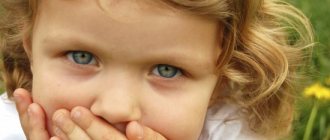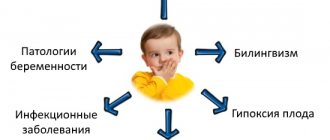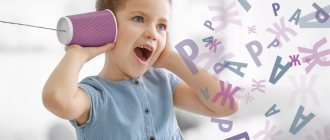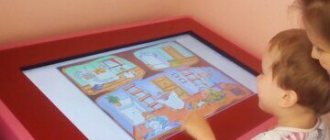There are certain sensitive (favorable) periods for the development of each mental cognitive process: thinking, memory, attention, perception and speech itself. It is very important that each stage of speech development, from humming to coherent speech, occurs in a timely manner. Starting speech in non-speaking children is a necessity if, at two years or more, the child does not speak at all, or pronounces babbling chains or several individual words.
It is very important for parents to understand that if you close your eyes to this problem, it will not only not disappear, but will only worsen the situation over time. Speech therapy work with non-speaking children should be carried out according to the characteristics and severity of the disorders.
What to pay attention to
When should you start sounding the alarm? So, this is necessary in cases where:
- The babbling chains of children are homogeneous, rare, and do not turn into words.
- By the age of 1.5 years, the intonation-rhythmic organization of speech in the baby is not formed.
- At 2-3 years old, a child does not understand speech addressed to him, even if an adult uses monosyllabic sentences and simple words.
- The child understands, but does not speak, or uses only a few words in communication. There is no phrasal, and especially coherent, speech.
- Physiological hearing impairment (deafness, hearing loss) was detected.
- The baby “speaks” in some kind of his own (bird) language, which no one understands.
Causes and mechanisms of the disorder
The reasons may be social or biological. The first group includes:
- Lack of communication (verbal, emotional) between adults and the child. The experiment with infants is based on comparing the psycho-emotional state of the subjects. For a certain period of time, some newborn children were placed in a room with white walls, isolated from extraneous sounds and other external stimuli. The children were not picked up; they were only given the necessary care. In another room there was a second group of subjects, where a favorable environment was created, the babies were not only fed and swaddled, but also picked up, rocked, and talked to. At the end of the experiment, when summing up the results, it was noted that the mental development indicators of the children of the first group were significantly lower than those of the children of the second. This experience confirms the fact that the lack of an emotional connection between mother and child and a lack of communication can further negatively affect the formation of speech.
- Using multiple languages in the family. Bilingual children are the name given to those who are raised in a bilingual family. If a child is exposed to speech in different languages, then at some point “stupor” may occur. Speech therapy work with such children should be carried out only in one (leading) language; if this condition is neglected, the situation can be aggravated. It is also undesirable for several speech therapists to work with the child, since different specialists may choose different methods for training, which will only complicate the perception of new material.
Biological reasons:
- Difficult or unnatural labor (eg, caesarean section and prolonged labor).
- Fetal hypoxia (lack of oxygen) during intrauterine development, which in turn leads to disruption of metabolic processes and a delay in the formation of the central nervous system.
- Birth injuries in a newborn: if the cerebral cortex is damaged, if the speech zone is affected, the manifestation of pathology will definitely be the consequence.
- Head injuries, especially at an early age.
- Infectious diseases suffered in the first year of life, which subsequently caused complications.
Classification of violations
A correctly made diagnosis plays a very important role, since the correctional technique included in the speech therapist’s work plan is effective for one type of disorder, but may be completely unsuitable for another. If we classify the types of speech disorders in non-speaking children, the following diagnoses should be noted:
- All disorders associated with speech pathology in children are combined into GSD (general speech underdevelopment). The diagnosis is general in nature, so if the child was given it after the examination, it is important to pay attention to its level, since OHP can be from the first to the fourth degree. If the speech therapy report shows ONR type I, this indicates that the child partially or completely lacks speech and (or) understanding of it.
- SSD (systemic speech underdevelopment) is a persistent disorder in children with disabilities (disabilities). Profound SUD is characterized by a disorder of coherent speech, a poor vocabulary and problems in understanding. The diagnosis can be made for children with mental retardation, severe mental retardation, cerebral palsy, etc.
- Alalia. This diagnosis indicates that the child either completely lacks speech itself or understands it. The first condition is typical for the motor type of pathology, the second – for the sensory one. If both reproduction and understanding are impaired, then a diagnosis of sensorimotor alalia is made. Such a conclusion can be given in parallel with childhood autism, but not necessarily. It should also not be confused with echolalia, a disorder in which there is repetition of ready-made speech structures: sentences, phrases, words. It looks like a child is imitating. The main task of this specific speech disorder, as paradoxical as it may sound, is interaction with others. Normally, all children repeat certain words or phrases after adults, this allows them to better remember new material and later use these constructions in their own speech. But in children with echolalia, this process stops at the initial stage. One of the main reasons for this may be damage to the central nervous system.
- Aphasia. This diagnosis can be made even to an adult. It differs from the previous one in that in this case certain speech areas of the cerebral cortex may be affected: the person will have difficulty expressing himself, or may not understand the speech addressed to him. Aphasia is often a consequence of a stroke.
- SRD (delayed speech development) is a lag behind the norms of development and formation of speech with initially intact intelligence. In other words, if a child uses only 5-10 words in his active vocabulary at two years of age, whereas normally these indicators reach 300-400, then, accordingly, the developmental disability is evident. However, only a qualified specialist can make an accurate diagnosis, since all types of disorders are similar to each other. If a baby at 2-3 years old uses only individual syllables or babble, and zero words, then this is not a delay; here the diagnosis will be more serious.
Most often, problems in the development of one mental function entail a lag in the formation of other cognitive components: when speech is delayed, attention, memory, and thinking are impaired. Therefore, at 3-4 years old, a child with mental retardation development will most likely be diagnosed with mental retardation disorder - delayed psycho-speech development. Children with this diagnosis are recommended to study in a correctional institution, since speech therapy work alone will not be enough in their case.
Several diagnoses can be written in the diagnostic chart at once. For example, they can write related ones, such as autism, echolalia, mental retardation, etc. However, you should not be afraid of the medical reports obtained based on the results of the examination. Effective comprehensive correctional work, especially started in the early stages, will bring it to a high-quality level and compensate for deficiencies in psycho-speech development.
For most of the listed violations, defectological assistance is required.
Starting speech in non-speaking children from zero to phrase speech is necessary primarily for those who suffer from alalia. The most difficult thing is to work with children diagnosed with the sensorimotor type of this disorder. In this case, other specialists are also involved, in particular, a defectologist and a psychologist are directly involved in the process of correcting disorders in alaliks. First, the work will be aimed at developing understanding, then only speech motor skills.
Article:
Activation of speech imitation.
The problem of delayed speech development, among other things. and among non-speaking children, it is becoming increasingly relevant. The child’s speech development must go through all stages of speech: at 2-3 months – humming (sounds “k”, “x”...); at 6-8 months - babbling (pa-pa-pa, ma-ma-ma-ma...); at 1 year - about 10 words (av-av, give, na, mom, dad, ...); by the age of 2, the active vocabulary (this is when the child pronounces these words) is already about 300 words; and at 3 years old it reaches 1,000 words.
What to do if a child has practically no speech by the age of 3-5 (“speaks” about 10 incomprehensible words)?
1. Urgently contact a speech therapist.
2. If there is no specialist, start the work yourself and “talk” to the children.
The crucial point in working with speechless children will be to create the need to imitate the words of an adult. This can manifest itself in any sound complexes. Therefore, it is necessary to create conditions in which the child would have a desire to pronounce (repeat) the same sound combinations repeatedly.
1. At the request of an adult, the child imitates sounds. The cries of birds and animals: “av”, “mu”, “ko-ko”, etc.; the chain of these onomatopoeia lengthens to 3-4 syllables: “av-av-av” (imitates the barking of a dog) or “ko-ko-ko” (imitates the cackling of a chicken."
During this period of speech development, children can name toys, familiar objects, actions performed by them or their loved ones, and also express their desires or reluctances in a sound form accessible to them. During this period, you cannot demand from the child the correct pronunciation of words, the correct sound pronunciation, the main thing is that he speaks, even if the child reproduces at least part of the words by imitation.
Activating children's speech or inducing speech imitation should be closely connected with the child's practical activities, with play, with a visual situation, which should be achieved under various but mandatory conditions: emotionality of contact with the child, a certain level of understanding of speech, stability of attention. The presence of imitative motivation. Much will depend on how interesting the games are, how deeply the positive emotions of non-speaking children are affected, and how inventive the adults are.
To achieve the desired effect in activating imitative speech activity, one must begin with the development of imitation in general: “Do as I do.” It is necessary to teach children to imitate actions with objects (for example, playing ball), teach them to imitate the movements of arms, legs, and heads (“Let’s fly like birds”; “Let’s stand on one leg,” etc.).
2. You can perform breathing and vocal exercises to lengthen speech exhalation.
For this purpose, children are invited to smell flowers, warm their hands, blow a soap bubble, etc.; draw out the sounds “a-a-a-a” (the girl is crying), “o-o-o” (the trumpet is humming), “ay” (the children are lost), “i-i-i” (the mouse is crying), “wa "(Lalya cries), "oh-oh-oh" (bitten by a wasp).
3. Do lip exercises. For example, make a straw; stop the horse (“whoa”); alternately stretch your lips into a tube and then show your teeth.
4. Do exercises for the tongue. For example: licking lips; show how a cat laps milk; give “injections” in each cheek; “brush” your teeth with your tongue; click your tongue.
It is advisable to carry out game techniques that combine breathing exercises, movements and pronouncing individual sounds and syllables.
An adult reads the text. And the children perform the appropriate movements and pronounce individual sounds and syllables.
"Small house, big house"
Adult. The bear has a big house, oh, oh, oh (they spread their arms to the sides)
Children (angrily). Oh, oh, oh (raise your hands up)
Adult. And the hare’s is small, ah, ah, ah (plaintively)
Children (complainingly). Ay, ay, ay... Children squat and exhale. Lower your head and cover your knees with your hands.
Adult. Our bear went home (the children waddle).
Children (angrily). Oh oh oh.
Adult. And a little bunny.
Children (jump on two legs). Ah ah ah.
5. Induce amorphous words in the child, i.e. the child pronounces words, onomatopoeia, as he knows how, as he succeeds.
Sound combinations are selected based on the child’s capabilities. In some children, labial sounds are easier to evoke (“ba-ba”, “mu-mu”), in others - posterior palatal sounds (“ka-ka”, “ha-ga”), in others – anterior palatal sounds (“di-di”, “ ti-ti").
Successful sound complexes must be repeated in a playful way with the child several times (up to 5-6 repetitions). Pronounce these sound combinations: sometimes quietly, sometimes loudly; sometimes slowly, sometimes quickly; sometimes angrily, sometimes tenderly, sometimes affectionately. Inducing speech imitative activity is good to combine with breathing, vocal and articulation exercises. It is better to give articulation exercises only in a playful way.
1) The names of persons close to the child: mother (“ma”), dad (“pa”), woman (“ba”), uncle (“dya”), aunt (“tya”, “t”).
2) Names of close persons or toys, dolls: Olya (“o”, “oya”), Nina (“ni”), Vova (“ova”, “va”).
3) Requests: give, na (“dya”, “nya”), where (“de”), there (“tya”), here (“de”). Expressing a desire to repeat something again: more (“iso”; “sho”).
4) Expressing one’s state with interjections “ay”, “oh” (it hurts), “shhh” (quieter).
5) Imitation of animal cries: dogs - aw-aw, am-am (“af”); cows - mu-mu ("u"), donkey - ia.ia ("a"), cats - meow-meow ("ay", "miyau"), goat - be-be "("pee-pee") .
6) Imitation of screams, squeaks: mosquito - i-i-i, birds - pi-pi-pi or ti-ti-ti (“and”, “ti”), cuckoos - ku-ku-ku (“uku”) ; chickens - ko-ko-ko, ko-ko-ko (“eye”); frogs - kva-kva-kva (“va-va”), tyap-tyap (“yap”).
7) Calling animals and controlling animals: cat - ks-ks-ks or kitty-kis-kis; scatter (“beat”); control of the horse - but (let's go), pru (stopped); call the chickens - tip-tip-tip or chick-chick-chick.
 Imitation of musical toys: pipe - doo-doo-doo (“du”); balalaika – la-la-la (“I”); to the bell - bom-bom-bom (“om-oh”).
Imitation of musical toys: pipe - doo-doo-doo (“du”); balalaika – la-la-la (“I”); to the bell - bom-bom-bom (“om-oh”).
9) Imitation of traffic noises: car - beep, beep, di-di; to the plane - ooh-ooh (in a low voice); steam locomotive - tu-tu.
10) Imitating the noise produced by an object when falling - bang or bang (“ah”, “wah”); the sounds of footsteps - top-top-top (“op-op”), the sound of a hammer - knock-knock (“toot-too”); drops of water - drip-drip.
11) Emotional exclamations: ah, oh, oh-uh (“uh”).
6. Invite children to name their toys, familiar objects (or object pictures); Distortions and substitutions of sounds are acceptable.
Approximate lexical material
Pussy, bunny, bear, fish, goat, dog, Petya, squirrel, fox, donkey.
Ball or ball: (“agi”), mushroom or fungus (“gt”), house or hut (“omi”), cube (“ku”), car (“sina”), airplane (“ate”), steamship ( hunt").
Note. To activate speech, we recommend using shopping games (children buy toys, objects) “Find out a new toy” 9 children name a toy that suddenly appears that was hidden from him), “arrange the toys as I say, and then name them yourself”, “Who is faster will bring a toy”, “Prompt the right word” (the adult reads the poem, the children prompt the rhyming word. If the child does not understand at the beginning of this type of work), what word needs to be added, you can put an object, a picture for a hint, or draw and color everything yourself hints).
7. Offer to repeat after the adult the names of the subject pictures. You can organize a lotto game. An adult pronounces stressed vowels in words clearly and at length. Children pronounce words as best they can. It is advisable to then practice the pronunciation of the vowels a, o, u, and (under stress).
For example: shaaaapka.
A: Anya, Alik, Katya, tata, ball, sleigh, slippers, hat, stick, poppy, bunny, cancer, boy, finger, cup.
A: Olya, Kolya, Zoya, donkey, house, boots, goat, mouth, cat, nose, spoon, cat, boat.
U: duck, fly, cube, shoes, ears, teeth, lips.
And: Dima, kitty, Inna, mushroom, linden, Zina, Nina.
8. Induce two-word sentences in children by combining the words where, give, on, here, here and pronounced from tasks 6.7.
Where is the ball? (“de me?”) – Here is the ball (“ot ati”).
Where's the car? (“de sina?”) – Here is the car (“ot sina”).
Give me the car (“dya sina”, “dya si”).
Give kisu (“dya ki”, “give ks”, “dya ks”).
An adult must create a situation so that the child uses the words na, give, here, take.
I g r o v o y r i m
Toys whose names children know are hidden. If a child asks an adult a question that includes the word “where” and the name of the toy (in any pronunciation), then the adult gives the toy that the child asked about.
9. Teach your child to express his desires verbally:
let me drink (“dya pi”) I’m thirsty (“atyu pi”)
give me more (“dya isyo”) I want to go for a walk (“atyu guya”)
mom, let’s go (“mama we’re going”) let’s go for a walk (“de gui”)
let's go home ("de amo")
As a result of all the work done at this stage of oral speech formation, children must learn to passively correlate objects and actions with their verbal designations. Passive vocabulary (which the child does not yet speak, but understands) should consist of the names of objects that the child often sees; actions that he himself performs or those performed by persons familiar to him; some of their states (cold, warm, hot).
Children should develop a need to imitate the words of an adult. Verbal imitative activity can manifest itself in any speech-sound expressions, without correction (correction) by an adult.
List of used literature
N.S. Zhukova. Speech therapy. Ekaterinburg ARD LTD 1998
L.P. Golubeva. Speech development in non-speaking children.
L.M. Chudinova. Techniques for activating speech among alaliks. Moscow. VLADOS. 2003
Corrective work for sensory alalia
Speech therapy work with non-speaking children 3-4 years old suffering from alalia is structured depending on the type of this disorder. If a diagnosis of sensory alalia has been established, then the speech understanding disorder will be corrected by working with intact analyzers, that is, through tactile, olfactory, gustatory and visual perception. The auditory system is not ignored, but is included in the work partially and only at later stages.
There are several stages of work to correct and eliminate speech disorders in the sensory type. Conventionally, they can be divided into:
- Stage I – preparatory.
- Stage II – formation of communication skills (from non-speech to speech).
- Stage III – development of interest in surrounding non-speech and speech sounds.
First stage
Before starting correctional work to eliminate speech disorders, it should be understood that, although it is customary to take methodological developments adapted for hard of hearing and deaf children as a basis, nevertheless, lack of hearing and misunderstanding of speech are two completely different concepts and require radically opposite in some cases approach. This must be taken into account when choosing techniques and methods for teaching children with sensory alalia.
These children hear, but the process of analyzing the information received is disrupted: the auditory analyzer can perceive the signal at the moment, but after some time under the same conditions it cannot. In the familiar environment of their home, they can remember individual speech structures used by adults. At the same time, when they find themselves in an unfamiliar environment, or when they come into contact with a new person, they do not understand the same statement. The auditory system of alaliks is extremely unstable; children with this perception disorder have a hard time tolerating sharp sounds (creaks, rustling), high-frequency noises, screaming or loud expressive speech. All this can lead to blocking the acoustic-gnostic process, which will only complicate the correction work. Therefore, during classes with such children it is necessary to use calm, quiet speech so as not to reduce their perception of speech sounds.
Often concomitant disorders in children with sensory or sensorimotor alalia are disturbances in the emotional-volitional sphere and behavior, so at first, classes with the child will most likely be chaotic, spontaneous. Under no circumstances should you try to force an alalik to “sit” in one place for a certain number of minutes. One of the main initial tasks is to establish contact with the child at the level of tactile and visual perception. Only after contact has been established can work begin, otherwise all efforts will go down the drain.
Second phase
Children, through joint play activities with a teacher, learn to use non-verbal communication skills - gestures, facial expressions. Later, semantic intonation is added. This happens when playing partner games with a child, for example:
"Feed the doll." The speech therapist speaks and shows what needs to be done: sits the doll on a chair (at the table), holds a spoon to the toy’s mouth, imitating “feeding,” etc. The child, in turn, performs the same actions, duplicating gestures and facial expressions. Here, motor and visual analyzers are actively involved in the work, the “eye to eye” technique is used, which allows the baby to better understand what the adult wants from him. However, this method is not suitable for children with autism, as they often tend to avoid eye contact with other people.
Games with construction sets or cubes will also be useful. This version of “parallel play” is also suitable for autistic people. Tactile and visual perception and sensation are involved. The teacher builds a tower or other structure together (if this does not cause negative emotions) or next to the child, using facial expressions and gestures. Speech is minimal, simple, monosyllabic, there should not be too many words in use, it is better to rely on those that the child perceives or can often hear.
You can also work with various aids for the development of sensory skills (color, taste, tactile features of objects) and fine motor skills: musical toys, soft and wooden cubes. The goal of the second stage is to directly formulate the need for verbal communication. It can be developed with the help of an artificially created “information hunger.”
Third stage
At this stage, the gradual development of phonemic hearing and perception begins. First with the help of non-speech sounds, then with the inclusion of adult speech. In this case, it is necessary to avoid sharp knocks, clapping of hands, and stomping. The sound is compared to the displayed image. For example, a speech therapist offers a pupil a number of illustrations for the development of subject vocabulary. Next, he parses each picture with one or more sounds corresponding to it (uu - paravoz, yy - bear, mu - cow, etc.). The same thing happens when the symbols of actions are activated: a selection of plot pictures allows you to expand the verbal dictionary (aa - cries, ay - hurts, etc.).
You can use ready-made material “My First Words” by N. A. Shishkina, developed in accordance with the modern psycholinguistic approach, and systematized into blocks for more convenient study of information. This manual is suitable for working with both sensory and motor skills.
Before starting work, it is recommended to establish a routine, clearly define the time for classes and rest. You need to try once again not to overload auditory attention and perception with speech tasks.
This stage will be fundamental in the development of speech understanding, as it will allow:
- intensify the use of words according to their purpose;
- develop the ability to analyze one’s own speech;
- replenish passive vocabulary, which, subject to the effective work of the speech therapist, will eventually turn into active;
- develop phonetic-phonemic perception: distinguish words that sound similar.
We start talking while playing
Play is the leading activity for children; speech development is possible only through joint games and activities with an adult. Start with the simplest exercises so that the child can easily master them and constantly be in a situation of success.
Sounds and hands
Move your arms and legs and make a specific sound for each gesture. For example, we spread our arms to the sides and sing: “Ahhh”, put our palms to the corners of our mouth for “Uuuu”, put our feet shoulder-width apart for “Iiiiiii”, interlock our fingers and raise our hands above our heads for “Ooooh”, etc. .
Let's play ball
Sit on the floor with your child, spread your legs wide, throw the ball to the baby and say, “Let's play! Catch the ball, catch it,” emphasizing the verb “catch” with intonation. This way, you will encourage your child to say the word when he throws the ball back to you. Do the same when you roll the ball: “Roll the ball, roll!” The game should be emotional, so don't skimp on encouragement and praise.
"Alarm"
Children usually enjoy this exercise. Before performing it, it is advisable to make sure that the child has a rough idea of what a clock is. Say that now you will turn the baby into an alarm clock, and “wind up” him: make several circular movements with your finger on the child’s palm, stomach, head or back, saying: “tick-tock”, “tick-tock”. Now it should ring: shake your palm rhythmically, accompanying the movements with the sound “zzzzz”. Then suggest to your baby that you should be the alarm clock, and he should set you off. At first, help your child pronounce the necessary words and sounds; the more often you repeat the game, the faster he will remember these onomatopoeias.
"Train"
Stand with your child one behind the other, explain to your child that now you are train cars and will make many interesting journeys. Each family member can become a carriage in your train. As you move, make sounds like “tu-tuu-tu, chuh-chuh-chuh, tuuuu!”, encouraging your child to say them with you. While traveling around the apartment, comment on everything you see: “here is the washing machine, and here is the kitchen, now we’ll go to the nursery to get toys,” etc.
"Drip-drip-drip"
For this activity you will need a set of small colored dish sponges. Place two bowls on the table: one empty and the other with water, place sponges nearby so that the child can choose any one. Take one, wet it and squeeze it into an empty bowl, saying “drip-drip-drip.” Invite your child to do the same with other sponges.
"Bubbles"
This game helps the child learn to control his speech organs. You blow soap bubbles, and the child must pop them, simultaneously pronouncing paired sounds: “b” - “p”, “v” - “f”, “t” - “d” and others. Help your child by saying sounds with him.
"Talking Ball"
Take a small ball that fits in your palm, you can crochet it and fill it with rice or cereal, then it will gently massage children's hands. Transfer the ball from hand to hand and pronounce the sounds first (it is better to start with vowels and voiced consonants), and then, as the child masters the exercise, the syllables: KI-SA, MA-MA, BA-BA, DE-DA, etc. d.
"Wonderful locker"
You will need a small cabinet or chest of drawers with a large number of compartments. It can be made from shoe boxes by gluing them together. When your baby is around, hide a toy or an object that is familiar to him in one of the drawers. The child must find it, take it out and name it.
"Bul-bul"
Prepare a large bowl of water, colored small pebbles, beads, buttons, shells, etc. Throw objects into the water with your baby, repeating for each throw: “boom”, “boom”.
"Ball"
To play you need a small light ball or a regular balloon (without helium, otherwise it will fly away immediately). You need to throw it up, saying: “Wow! Wow! Wow!
"Tsap-tsap"
Place your child at the table so that his elbows rest on the table. At a distance approximately equal to the length of your forearm, place small objects such as beads or buttons. Place a box nearby. Now the child, without lifting his elbow, must take the object with his fingers with the word “Tsap-tsap” and transfer it to the box with the sound “Bang!” By the way, you can arrange a competition when the child masters the game well.
Another piece of advice: try to create situations as often as possible when the child may need this or that object, a toy, and ensure that he makes at least an attempt to name it.
Remember that the child is unlikely to understand how to do the exercise correctly the first time, so be patient and explain and show again and again. By practicing for 10-15 minutes every day, you will definitely achieve success, and your baby will delight you with his first words!
Corrective work for motor alalia
Motor alalia is characterized by underdevelopment of expressive speech or its absence; in this case, classes with a specialist will be aimed at starting speech. The preparatory stage of speech therapy work is aimed at evoking speech sounds, using the pitch, strength of the voice, and its rhythmic and intonation components. To do this, they use the method of “singing” vowels when merging sounds into syllables, or in isolation. At the same time, finger exercises, breathing and articulation exercises are used.
Corrective activities carried out at the main stage are based on:
- development and expansion of passive vocabulary;
- activation of new words;
- formation of the grammatical aspect of speech;
- formation of phrasal speech;
- development of coherent speech.
In the future, it will be necessary to correct the sound pronunciation. This work is carried out as part of the formation of a grammatical structure.
Evoking speech in non-speaking children with motor alalia, as well as with sensory alalia, is carried out in several stages from simple to complex, but with one difference: the need for communication in children of this group is not impaired, therefore the method of “information hunger” is not used in this case . On the contrary, a child with motor alalia needs qualitatively new information.
“My first words” by N. A. Shishkina
This method of starting speech in non-speaking children is also based on the principles of developmental education and the unity of educational, training, development and correctional goals. The emergence and development of speech occurs as a result of the child’s various activities. First, the baby masters vowel sounds, and then adds consonants to them, the order of learning is from simple to complex.
To study each sound, you are given as much time as necessary in this particular case. The speech material of the technique was developed and tested by N. A. Shishkina over ten years. It is presented in the author's workbook “My First Words.” This manual is suitable for both children who more easily learn the sound characteristics of speech, and for children who are better able to understand the syllabic characteristics of speech.
It is recommended to start practicing according to Shishkina’s method from an early age.
How to work with a non-speaking child using Shishkina’s benefits? The first step is to elicit a vocal response to vowel sounds. Then it is important to teach the child to repeat words after an adult in the most convenient form for him; here the quality of pronunciation does not matter, since the main goal is to expand the vocabulary. N.A. Shishkina, who recommends adhering to the following rules:
- An adult’s speech should be emotional and consist of clear, specific instructions and explanations such as “show”, “hide”. It is advisable to accompany words with gestures and facial expressions, since for speechless children such “language” is most understandable.
- All actions are performed from left to right and from top to bottom, this subconsciously accustoms the child to reading and writing, albeit in the distant future.
- There are only six pictures on the sheet, which corresponds to the visual perception of a preschool child. The order of naming the pictures must be changed every lesson.
- The adult first completes each task himself, then either the child repeats the exercise independently or with the help of an adult.
Practicing each task consists of four exercises, which are called:
- “Picture-symbol” introduces the child to sound and helps create a play situation;
- “Magic Buttons”, an exercise aimed at eliciting a vocal response. Multi-colored square buttons are “pressed” with the index finger, and the sound is pronounced only once;
- "Soundtracks". Here the child needs to attach the sticker to the desired square. Then, running his finger along the path, the child pronounces the syllable.
- “Say the words with the sounds you are learning.” The adult selects the desired sticker, reads the word, then asks the child to place the sticker where it should be, name the sound and circle the corresponding letter with a pencil.
On average, you need to use two stickers per practiced sound per lesson. Gradually the tasks become more difficult.
Forecasting and corrective measures
The sooner the work begins, the greater the chance of compensating for speech impairment in children with mild or moderate forms of underdevelopment of certain mental functions. The task of corrective influence on children with severe forms of pathology is to support and develop as much as possible communication and self-care skills, so that in the future special children have the opportunity to socialize in society.
The most important condition when starting a speech is the timeliness of correctional work and an integrated approach. In parallel with pedagogical classes, for any speech disorder that has a biological cause, a course of treatment with medications corresponding to the established diagnosis is prescribed. If the cause of mild RRD in a child with intact intelligence is found to be weak innervation of the organs of the speech apparatus, it is recommended to include speech therapy massage and articulation gymnastics in the complex of classes as a preventive measure.
If already at the age of 2-3 years the child was diagnosed with sensory alalia, and the baby’s parents turned to a speech therapist for help only at the age of 5-6, then you need to understand that the underdevelopment of speech has progressed over all this time. At this age, sensorimotor alalia is already established in all children.
Non-verbal children with disabilities are often homeschooled. Their parents are required to take a direct part in the speech therapy process.






